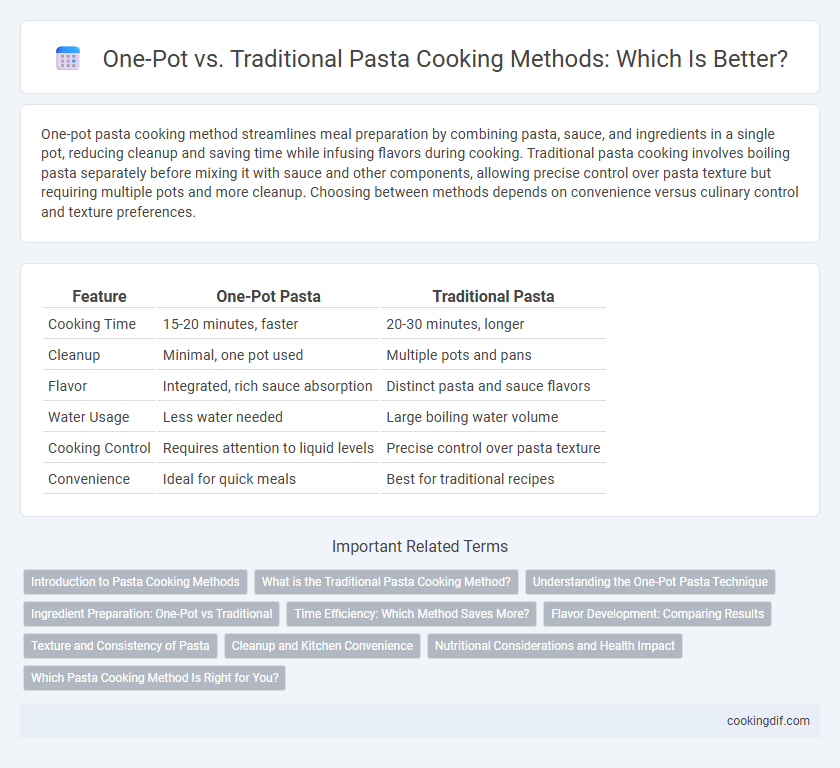One-pot pasta cooking method streamlines meal preparation by combining pasta, sauce, and ingredients in a single pot, reducing cleanup and saving time while infusing flavors during cooking. Traditional pasta cooking involves boiling pasta separately before mixing it with sauce and other components, allowing precise control over pasta texture but requiring multiple pots and more cleanup. Choosing between methods depends on convenience versus culinary control and texture preferences.
Table of Comparison
| Feature | One-Pot Pasta | Traditional Pasta |
|---|---|---|
| Cooking Time | 15-20 minutes, faster | 20-30 minutes, longer |
| Cleanup | Minimal, one pot used | Multiple pots and pans |
| Flavor | Integrated, rich sauce absorption | Distinct pasta and sauce flavors |
| Water Usage | Less water needed | Large boiling water volume |
| Cooking Control | Requires attention to liquid levels | Precise control over pasta texture |
| Convenience | Ideal for quick meals | Best for traditional recipes |
Introduction to Pasta Cooking Methods
One-pot pasta cooking combines boiling, simmering, and mixing in a single pot, reducing cleanup and saving time while enhancing flavor absorption as pasta cooks directly in the sauce. Traditional pasta cooking involves boiling pasta separately in a large pot of salted water, followed by draining and mixing with sauce, which helps achieve precise texture control but requires more steps. Both methods impact texture and taste, with one-pot offering convenience and infused flavors, while traditional allows for flexible sauce preparation and pasta doneness management.
What is the Traditional Pasta Cooking Method?
The traditional pasta cooking method involves boiling pasta in a large pot of salted water until al dente, then draining it before adding sauce. This approach ensures even cooking and allows for precise control of texture and doneness. It requires separate cooking of sauce and pasta, which is combined just before serving for optimal flavor integration.
Understanding the One-Pot Pasta Technique
The one-pot pasta technique streamlines cooking by combining all ingredients--pasta, sauce, and seasonings--in a single pot, allowing the pasta to absorb flavors directly during the cooking process. This method enhances starch release, creating a naturally creamy texture without additional cream or cheese. Traditional pasta cooking separates boiling and sauce preparation, requiring more time and cleanup, while one-pot pasta offers a quicker, efficient alternative with intensified flavor integration.
Ingredient Preparation: One-Pot vs Traditional
One-pot pasta cooking reduces ingredient preparation by combining all components--pasta, sauce, and seasonings--in a single pot, minimizing chopping and measuring time. Traditional pasta preparation requires separately boiling pasta, preparing sauce with multiple ingredients, and precise timing to achieve optimal texture. This streamlined one-pot method increases kitchen efficiency while preserving flavor complexity.
Time Efficiency: Which Method Saves More?
One-pot pasta cooking significantly reduces overall preparation and cleanup time by combining all ingredients in a single pot, allowing the pasta to cook simultaneously with the sauce and other components. Traditional pasta cooking involves boiling pasta separately, draining, and then mixing it with sauces, which increases total cooking and handling duration. Studies show one-pot methods save up to 30% more time compared to traditional multi-step cooking, making it ideal for quick meal preparation.
Flavor Development: Comparing Results
One-pot pasta cooking enhances flavor development by allowing the pasta to absorb the cooking liquid, which is infused with herbs, spices, and other ingredients, resulting in a richer and more integrated taste. Traditional pasta cooking, involving boiling and draining, often leads to the loss of starch and flavor compounds in the water, reducing the overall depth of flavor in the final dish. The one-pot method maximizes the retention of aromatic oils and nutrients, creating a more robust and cohesive flavor profile.
Texture and Consistency of Pasta
One-pot pasta cooking method produces a creamier and more cohesive texture as the starch released during cooking combines directly with the sauce, enhancing flavor absorption and creating a silky consistency. Traditional cooking involves boiling pasta separately, which allows more control over individual pasta doneness but often results in a less integrated sauce and slightly firmer texture. The one-pot technique favors a softer, more uniform bite, while traditional methods maintain distinct pasta firmness and sauce separation.
Cleanup and Kitchen Convenience
One-pot pasta cooking significantly reduces cleanup by combining all ingredients in a single pot, minimizing the number of dishes used and shortening washing time. Traditional methods require multiple pots and utensils, increasing both cooking complexity and post-meal cleanup efforts. One-pot approaches enhance kitchen convenience by streamlining meal preparation and reducing countertop clutter.
Nutritional Considerations and Health Impact
One-pot pasta cooking retains more nutrients by minimizing water use and reducing nutrient loss during boiling compared to traditional methods where pasta is drained, leading to vitamin and mineral depletion. The one-pot method preserves the pasta's starches, enhancing glycemic control by offering a slower glucose release. Traditional pasta cooking, while effective for texture, may result in higher calorie intake due to added fats and sauces often incorporated after draining.
Which Pasta Cooking Method Is Right for You?
One-pot pasta cooking streamlines meal preparation by combining ingredients into a single pot, reducing cleanup and saving time, ideal for busy individuals or beginners. Traditional pasta cooking involves boiling pasta separately and then mixing with sauces, offering greater control over texture and flavor customization preferred by culinary enthusiasts. Selecting the right method depends on your priorities: convenience and speed favor one-pot pasta, while precise taste and presentation benefit from the traditional approach.
one-pot vs traditional for pasta cooking method Infographic

 cookingdif.com
cookingdif.com